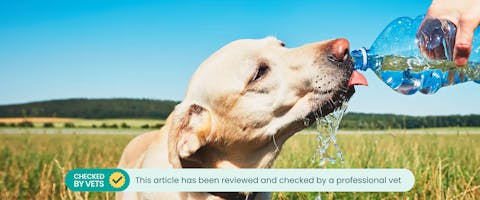Updated 17/05/2023
During the hot summer months, dogs and cats can become increasingly at risk of heatstroke. While cats like to sunbathe, they tend to know when they have had enough and will move to a more shaded spot. Dogs, on the other hand, are not always quite so smart and may need to be moved from the sun by a caregiver.
Unlike humans, dogs do not sweat. Their primary cooling method is panting, however, when the temperature outside gets close to matching the dog’s body temperature, panting becomes ineffective and the dog can become at risk of heatstroke.
Although any animal can overheat, pets that are obese or brachycephalic (flat-nosed breeds, such as Pugs or Persian cats) are more susceptible to heatstroke as it becomes increasingly difficult for them to use their airway to pant effectively. These breeds are also particularly prone to their airways collapsing if they are stressed/panting, this can be fatal. For this reason, you should always discuss what steps to take in the hot weather with your dog’s veterinarian.
Older dogs and dogs which are overweight are also especially at risk of heatstroke. Your veterinarian will be able to advise on how best to manage this for your dog’s individual case.
It’s also important to keep in mind that panting is quite a tiring activity for your pet. Prolonged panting can lead to exhaustion/breathing discomfort for any dog, regardless of breed/age. Because panting involves your dog losing water/moisture, it can also make them very dehydrated, which can lead to serious problems.
Here are some signs to look out for that your pet might be suffering from heatstroke:
- Faster, heavier breathing or panting
- Thirstier than normal
- Drooling
- Whining or showing signs of agitation
- Faster heartbeat
- Gums turn a darker colour than normal (such as dark pink or red)
- Staggering
- Weakness, lethargy or collapse
- Seizures/shaking/ tremoring
- Unconsciousness
If you suspect your pet is suffering from a heat-related condition, take them to a cool place and offer them a drink of water while seeking immediate veterinary advice by phoning your veterinary clinic.
How can I prevent my pet from overheating?
To help prevent your pet from overheating, ensure they always have access to fresh water and make sure there is enough ventilation within the room. Sometimes an open window is not enough, particularly if your pet is less mobile – instead, consider using an electric fan and take their water bowl to them regularly. It is also important to make sure that there is a source of shade in the room your pet is in. Ideally, keep curtains/blinds closed during the hottest parts of the day. This will help avoid a “greenhouse heating” effect in the room and thus, help keep your pet more comfortable.
Avoid exercising your dog in the heat during the day – mornings and evenings are usually cooler, and remember the 5-second rule: if it hurts your hand to touch the pavement for 5 seconds, it will hurt your dog's paws to walk on it, too!
Parasites love the warmer weather too, so make sure your pet's flea and tick treatments are up to date.
Finally, never let your pet rest for too long in direct sunlight – this includes inside conservatories, in front of windows, and out in the garden, and NEVER leave your pet inside a car.
Heatstroke is extremely dangerous and often fatal in dogs. They can experience multiple organ failure and extreme discomfort, distress and even death. It’s recommended to discuss with your veterinarian how best to keep your individual pet from overheating during the hotter months of the year. If you think your pet may have heatstroke, contact your veterinary clinic immediately for advice on what to do next.
Trending posts
Purr-use some of the top blogs our members have been loving this month- Top male dog names for your new furry friendGot a new furry family member in your pack? Check…

- Top female dog names for your new fluffy palWelcoming a new pooch into your family? Explore…

- 250+ gray cat names your silver feline will loveRecently welcomed a fluffy gray bundle of joy into…

- What are normal pet sitting rates?Discover the average pet sitting rates for animals…

- Unique dog names to stand out from the packDare to be different with our list of the best…

Meet our veterinary expert, Evie
This article has been checked by veterinarian Evie Moloney RCVS. Evie is a vet surgeon who graduated from the University College Dublin, which is the only university offering the veterinary medicine degree in Ireland. She really enjoys surgery and has also worked as an emergency and critical care vet. She is passionate about sharing education about preventative health care
for pets, especially the importance of regular dog and cat teeth brushing at home. She also enjoys helping owners find practical solutions for keeping pets as comfortable as possible while living with conditions such as arthritis. When not working, she enjoys hiking and swimming.
TrustedHousesitters is here to keep pets safe and happy, which is why all members have unlimited access to a free 24/7 Vet Advice Line while on a sit. Simply call the number on your dashboard for expert advice from a team of veterinary nurses.
